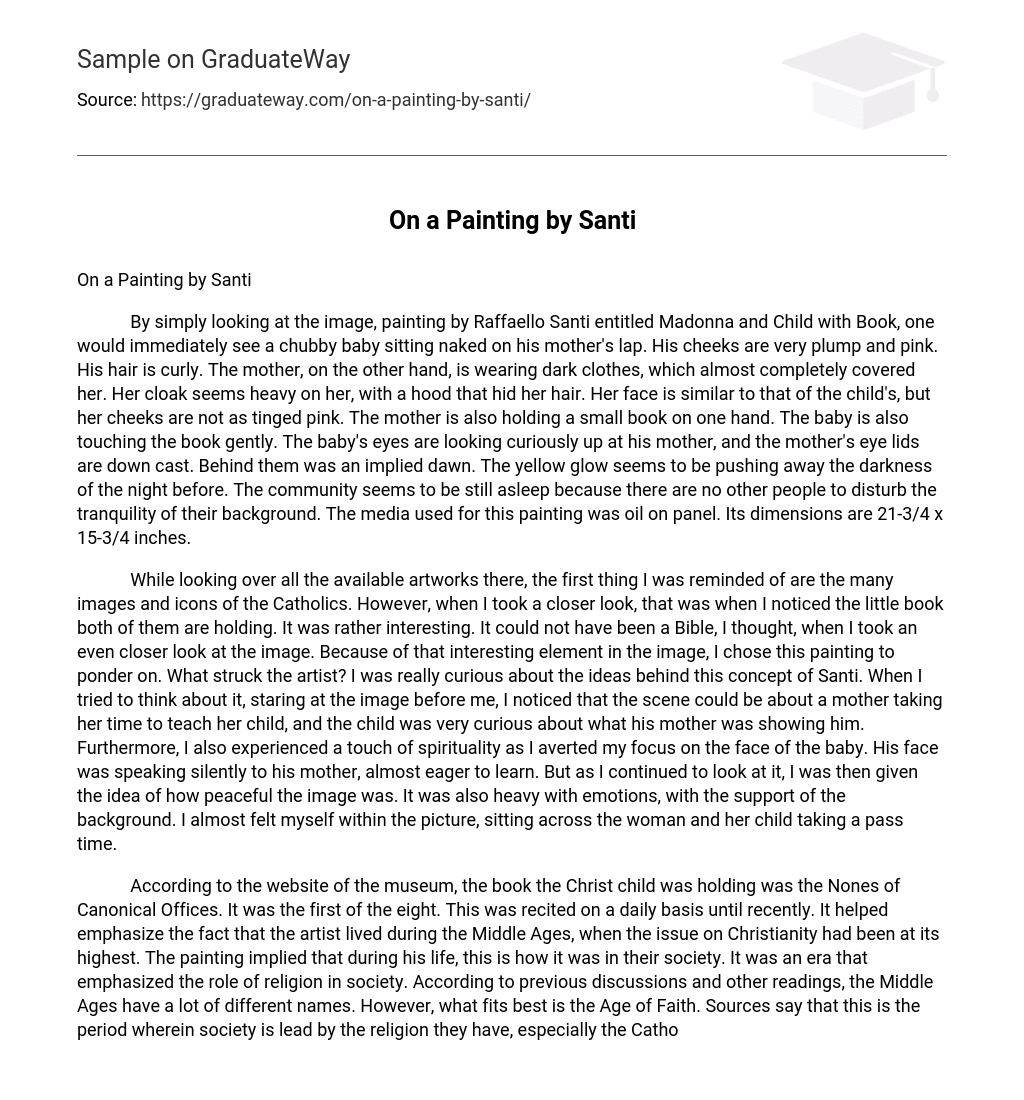By simply looking at the image, painting by Raffaello Santi entitled Madonna and Child with Book, one would immediately see a chubby baby sitting naked on his mother’s lap. His cheeks are very plump and pink. His hair is curly. The mother, on the other hand, is wearing dark clothes, which almost completely covered her. Her cloak seems heavy on her, with a hood that hid her hair. Her face is similar to that of the child’s, but her cheeks are not as tinged pink. The mother is also holding a small book on one hand. The baby is also touching the book gently. The baby’s eyes are looking curiously up at his mother, and the mother’s eye lids are down cast. Behind them was an implied dawn. The yellow glow seems to be pushing away the darkness of the night before. The community seems to be still asleep because there are no other people to disturb the tranquility of their background. The media used for this painting was oil on panel. Its dimensions are 21-3/4 x 15-3/4 inches.
While looking over all the available artworks there, the first thing I was reminded of are the many images and icons of the Catholics. However, when I took a closer look, that was when I noticed the little book both of them are holding. It was rather interesting. It could not have been a Bible, I thought, when I took an even closer look at the image. Because of that interesting element in the image, I chose this painting to ponder on. What struck the artist? I was really curious about the ideas behind this concept of Santi. When I tried to think about it, staring at the image before me, I noticed that the scene could be about a mother taking her time to teach her child, and the child was very curious about what his mother was showing him. Furthermore, I also experienced a touch of spirituality as I averted my focus on the face of the baby. His face was speaking silently to his mother, almost eager to learn. But as I continued to look at it, I was then given the idea of how peaceful the image was. It was also heavy with emotions, with the support of the background. I almost felt myself within the picture, sitting across the woman and her child taking a pass time.
According to the website of the museum, the book the Christ child was holding was the Nones of Canonical Offices. It was the first of the eight. This was recited on a daily basis until recently. It helped emphasize the fact that the artist lived during the Middle Ages, when the issue on Christianity had been at its highest. The painting implied that during his life, this is how it was in their society. It was an era that emphasized the role of religion in society. According to previous discussions and other readings, the Middle Ages have a lot of different names. However, what fits best is the Age of Faith. Sources say that this is the period wherein society is lead by the religion they have, especially the Catholic Faith. The way people lived in this era can be summed up in this term. How they faced the next day was determined by the things they believed in. The way they judged others was also by their faith. With this, the symbolism lies on the total representation of the image—using a Madonna and Child. To further represent the nature of society back then, the book was used to represent a portion of the nature of their society. To have the painting called a Madonna is already a sign that their faith played a role in its creation. But to have the book simply assured and emphasize the fact that the painting was created during the Age of Faith. To summarize, the painting did not only allow one to feel a sense of spirituality, but one can also be brought back to partially experience the nature of life during those times. The elaborate strokes and details done on the piece can also make one feel the emotions felt by the characters in the painting. The piece particularly brought a link between what is seen and what can be perceived from the time it was painted. It brought the essence of the period.
Work Cited
Norton Simon Art Foundation. “Madonna and Child with Book.” Norton Simon Museum. 14 May 2008 <http://www.nortonsimon.org/collections/browse_title.php?id=M. 1972.2.P>.





